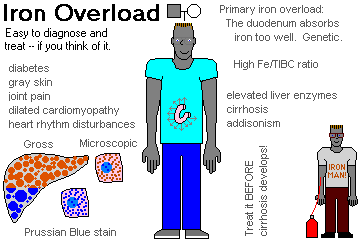

1, 3Īt the time of death, blood was collected for measurement of serum cytokines, assayed by commercially available enzyme-linked immunosorbent assay (BioLegend). Finally, hereditary hemochromatosis, which is a genetic disorder characterized by high intestinal iron absorption, also results in increased tissue iron accumulation. Other examples include congenital dyserythropoietic anemia and sideroblastic anemia. For example, iron overload is a feature in β-thalassemia intermedia, a condition for which most affected persons are not transfused. Nontransfusional iron overload can occur in conditions in which ongoing erythroid destruction leads to inappropriately high intestinal iron absorption. 1, 2 Because there is no way of excreting iron in humans, chronic transfusions lead to progressive and pathologic iron accumulation. Each unit of transfused blood contains 220 to 250 mg of iron bound to hemoglobin, an amount much larger than the 1 to 2 mg of iron that is absorbed daily to maintain normal human iron homeostasis. Patients with sickle cell disease and severe vaso-occlusive complications may also be placed on regular transfusions. Transfusion of red blood cells can be a life-saving therapy for patients with congenital or acquired anemias, such as the thalassemias, aplastic anemias, and myelodysplastic syndromes.

This is the first study to demonstrate that iron overload in mice results in increased bone resorption and oxidative stress, leading to changes in bone microarchitecture and material properties and thus bone loss. Treatment of iron-overloaded mice with the antioxidant N-acetyl-L-cysteine prevented the development of trabecular but not cortical bone abnormalities. Iron-overloaded mice had increased reactive oxygen species and elevated serum tumor necrosis factor-α and interleukin-6 concentrations that correlated with severity of iron overload. Compared with the placebo group, iron-overloaded mice exhibited dose-dependent increased tissue iron content, changes in bone composition, and trabecular and cortical thinning of bone accompanied by increased bone resorption.

To define the effect of iron excess in bone, we generated an iron-overloaded mouse by injecting iron dextran at 2 doses into C57/BL6 mice for 2 months. The exact role of iron in the development of osteoporosis in these disorders is not established. Osteoporosis is a frequent problem in disorders characterized by iron overload, such as the thalassemias and hereditary hemochromatosis.


 0 kommentar(er)
0 kommentar(er)
